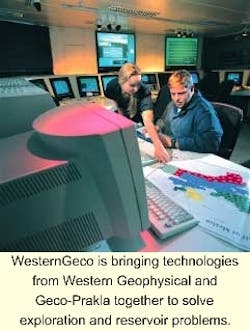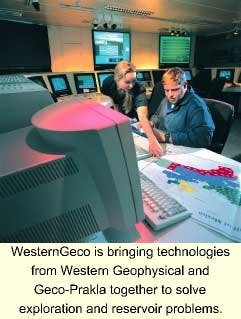SEISMIC EXPLORATION: Seismic research advancing on many fronts, but low prices limit applications
Offshore Magazine discussed changes in seismic data gathering and processing research, applications, and business trends with WesternGeco's M. Lee Bell, Ph.D., Vice President, Seismic Reservoir Services, and Salem L. El Sayed, Director, Global Marketing.
OFFSHORE: In recent years, Schlumberger, Geco-Prakla and Baker Hughes Western Geophys- ical (which have now formed WesternGeco) have had strong research efforts, but seemed to go in different directions. Can you explain the differences?
BELL: Geco had been concentrating technology developments on acquisition systems, especially with the rollout of the Q-system. Western had been working on acquisition systems as well, but placed more emphasis on data processing. One of the good things about the merger is that WesternGeco has the fruits of both.
OS: Where do you see research going?
EL SAYED: The direction is always toward finding ways to reduce risk and uncertainty. Certainly, improvement in signal fidelity is a key element that will enable us to extend geophysics further into reservoir development and management. We have the largest investment in research in the industry, and we'll continue that level of investment because differentiating technology is critical to providing value.
OS: What about solid streamer technology?
EL SAYED: We have several vessels with solid streamers in our fleet, which were committed from Western Geophysical, and we are looking closely at how we might further benefit from that technology in the future. We have operations underway in the Gulf of Mexico utilizing the Q-marine acquisition system and will extend these operations to the North Sea, and later worldwide.
OS: Where is the industry putting its money?
EL SAYED: There is a resurgence in the Gulf of Mexico and land activity in the Middle East. While activity in Brazil is declining a bit, West Africa is getting downstream interest.
OS: Are companies more interested in regional coverage or in smaller proprietary surveys?
EL SAYED: In frontier areas, such as Brazil, the regional understanding is critical, and sales of regional 2D as well as larger 3Ds are normal. However, there has been a real resurgence - at least offshore - in smaller, reservoir-oriented 3D/4D surveys in the mature provinces, especially the North Sea. We expect this trend to be the single most obvious change in the next couple of years.
In areas such as the Gulf of Mexico, we are just beginning to see more finely sampled, prospect-oriented 3D surveys appearing.
OS: How does this affect your data processing?
BELL: With a larger number of companies, it generates more interest, so there is more work, and more bulk processing rather than specialty processing. The main concern is not the volume of work, but the fact that prices are still very soft.
OS: What about the rising oil prices that have strengthened oil companies? Don't they have problems that need specialty acquisition or processing?
EL SAYED: Yes, they do. And while we haven't seen any surge in activity yet, we anticipate some improvement later this year.
OS: What are they using to explore?
BELL: They are working off their existing multi-client data that they have in-house. Also, many of them have not been in the big exploration game. They have moved into appraisal work and shooting smaller specialized programs. It is nothing like the scale we were working at before.
OS: Have you seen any move to detailed earth-model style surveys, shooting for 4D seismic?
BELL: There are encouraging signs from several fronts. Some of the majors and super-majors have proposed that 4D surveys be performed on most of their significant fields, and several are actually doing it now. Permanent installations for reservoir monitoring are also being installed in a few fields, which should result in the most detailed studies yet. This is one of the major objectives of WesternGeco's Q-technology, of course, in which the high resolution enables detailed reservoir models.
OS: An appraisal well at $40-50 million can buy a lot of detailed seismic work.
EL SAYED: Seismic is not yet considered a stand-alone, certified, reserves measuring tool. But as geophysics and reservoir engineering become more integrated, we expect that will become more of a reality.
OS: What about multi-component seismic for rock and fluid properties?
BELL: We have a substantial effort in those directions to make our case to the asset managers, reservoir and drilling engineers, to show in their terms the value that 4C seismic brings.
OS: Are these high-end processes being used with smaller fields?
EL SAYED: No, not yet. They are dealing with the bigger deepwater plays or the most established giants. Those techniques really become more available when the cost per lifted-bbl drops. The larger upside there is, the more likely the operator is to use the new technology.
OS: What is coming in the data processing sector?
BELL: Improved resolution, repeatable amplitudes, increased fidelity, and making use of both event times and amplitudes, so that there is increased confidence in the mechanical properties of the earth model. With improved signal fidelity, this is much more feasible. What is exciting, too, is that everything is becoming much more interactive. The better you understand the reservoir engineer's problems, the better you can design a survey to solve his needs.

